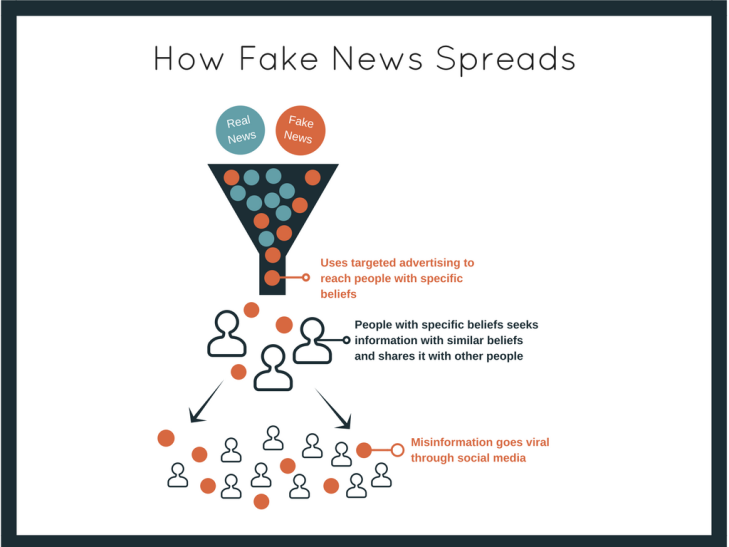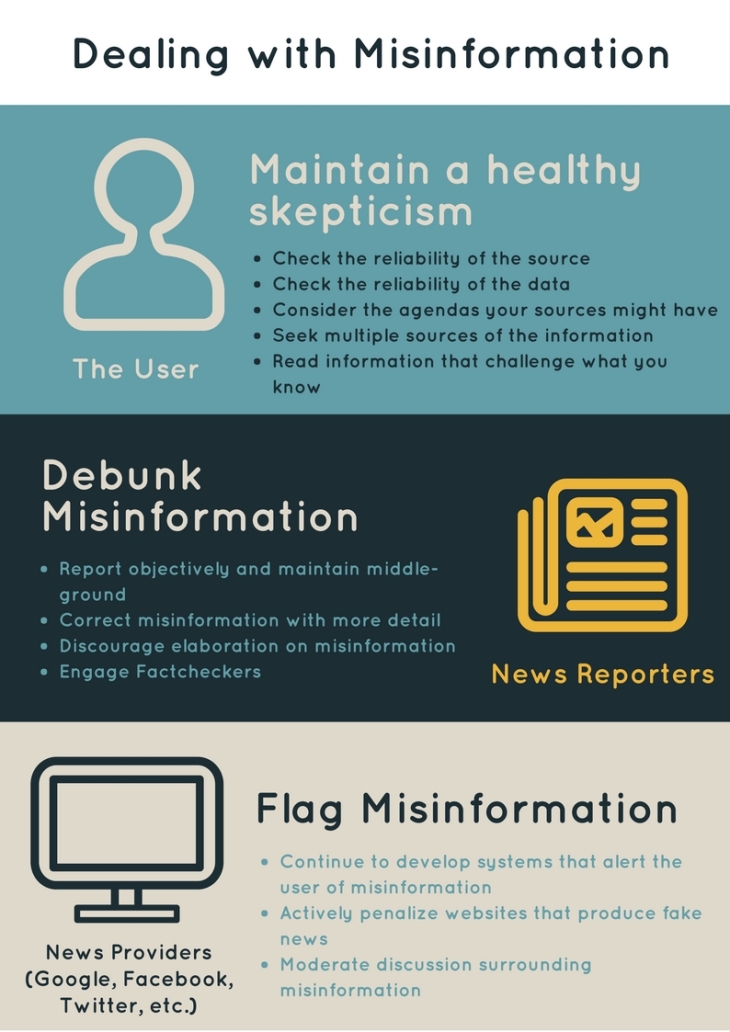2016 was a harrowing example of the polarising consequences of misinformation, marked by key events such as the US elections and Brexit. Since then, news providers (i.e Facebook, Google) have taken steps to address the issue.
The combination of our natural instinct to seek information that align with our own views, the algorithm of our news providers and their ability to target specific groups of people (Buchanan, 2017) has unwittingly made social media an environment fit for misinformation to thrive. It is also interesting to note that the effects of fake news persist even after the misinformation has been debunked (Chan et al., 2017).

(Source: Original)
It’s tempting to say that since the technology that encourages the pervasiveness of misinformation is based on our behaviour, that we are largely responsible for curating our news and assessing its reliability. After all, the type of content consumed on Facebook is strongly affected by the tendency of users to limit their exposure to just a few sites. (Schmidt et al., 2017)
However, not all internet users are digitally literate enough to assess the authenticity of online content. In fact, it is this group of people that purveyors of misinformation tend to target, as they are more likely to spread fake news to other people (Buchanan, 2017).
Furthermore, fake news can manifest in reliable sources. A recent example – Trump’s photo dumping fish food into a koi pond was reported out of context by several news outlets.

(Source: Mothership.sg, 2017)
The incident also showed us how the pressure to agree with the majority can contribute to the spread of fake news. (Sustein, 2017)
Therefore, efforts to overcome a post-truth society should be conscious of two things: the digital, information and data literacy of the individual as well as the environment the information lives in.

(Source: Original)
(Information from Futurelearn, 2017 and Chan et al., 2017)
(Word count: 302)
References
Buchanan, M. (2017). Why Fake News Spreads So Fast on Facebook. [online] Bloomberg.com. Available at: https://www.bloomberg.com/view/articles/2017-08-31/why-fake-news-spreads-so-fast-on-facebook [Accessed 15 Nov. 2017].
Chan, M., Jones, C., Hall Jamieson, K. and Albarracín, D. (2017). Debunking: A Meta-Analysis of the Psychological Efficacy of Messages Countering Misinformation. Psychological Science, 28(11), pp.1531-1546.
FutureLearn. (2017). Data Literacy – Learning in the Network Age – University of Southampton. [online] Available at: https://www.futurelearn.com/courses/learning-network-age/3/steps/263023 [Accessed 15 Nov. 2017].
FutureLearn. (2017). Information Literacy – Learning in the Network Age – University of Southampton. [online] Available at: https://www.futurelearn.com/courses/learning-network-age/3/steps/263022 [Accessed 15 Nov. 2017].
FutureLearn. (2017). Media Literacy – Learning in the Network Age – University of Southampton. [online] Available at: https://www.futurelearn.com/courses/learning-network-age/3/steps/263021 [Accessed 15 Nov. 2017].
Mothership.sg. (2017). Mainstream media worldwide report fake news about Trump dumping food on koi fishes. [online] Available at: https://mothership.sg/2017/11/fake-news-donald-trump-feed-fish-food/ [Accessed 15 Nov. 2017].
Schmidt, A., Zollo, F., Del Vicario, M., Bessi, A., Scala, A., Caldarelli, G., Stanley, H. and Quattrociocchi, W. (2017). Anatomy of news consumption on Facebook. Proceedings of the National Academy of Sciences, 114(12), pp.3035-3039.
Sunstein, C.. (2017). #Republic: Divided Democracy in the Age of Social Media. [S.l.]: PRINCETON UNIVERSITY PRES, pp.100 – 101.


Hi Shanelle! Nice blog post and rich content!
I found it interesting to your ideas about how the fake news is spread throughout the populations today.
With the growth of digital era, we cannot deny that the speed of spreading news today is promptness than in the past. Even though some “formal” news outlet uses some exaggeration title just to attract readers to their web page.
I agree with your point of view that, not all of the network users have the digital literacy to access the information which leads to serious consequences. This video has shown that a high percentage of our generations cannot distinguish between the real and fake news, hope this widen your horizons 😀
Interesting knowledge from your infographic of how to deal with misinformation! This definitely could help!
Therefore, education and positive knowledge should be cultivated into people’s mind nowadays in order to reduce the negative impact.
(150 words )
LikeLike
Hey Xin Yu, education and encouraging people to keep a healthy scepticism is very important! Thank you for the video, it’s definitely given me valuable input. I agree and think we should start young and incorporate into primary schools, and I the government should also step in a spread the word!
LikeLiked by 1 person
Hi Shanelle,
I am really impressed by the content of your infographic! A lot of us focused on evaluating how users can steer away from the fake news but conveniently left out what the reporters and news providers should do on their part.
Well, I came across an article on Channel NewsAsia that talked about how the Singapore government is planning to tackle the spread of fake news with new laws. I believe that this will help to tighten the spread of fake news on our local online space.
However, the article also mentioned that the government would still need to find ways to increase media literacy and teach critical thinking skills. Would you have any suggestions for the government on how to increase awareness and educate the people out there for this matter?
(135 Words)
Reference:
ChannelNewsAsia (2017) New laws on fake news to be introduced next year: Shanmugam – Chan Luo Er [online] Available at: http://www.channelnewsasia.com/news/singapore/new-laws-on-fake-news-to-be-introduced-next-year-shanmugam-8958048 [Accessed 16 NOV 2017]
LikeLike
Hey Siewmin, thank you for your kind words. Well, first of all, I think incorporating it into the schools is important. We need to communicate that it is valuable life skill to have and keep reiterating throughout their progress. I also think we need to target the elderly. Although we have posters around Singapore warning us of scams, it doesn’t highlight how convincing certain scams can be.
I think Shanmugam is right in saying we have to deal with the people who are spreading fake news. Google currently punishes flagged websites by removing their source of income: advertising. I think this is a good approach. Also, digital advertisers can engage tools to detect flagged websites (such as IAS) and pull their advertising too!
Google punishes websites:
https://www.reuters.com/article/us-alphabet-advertising/google-facebook-move-to-restrict-ads-on-fake-news-sites-idUSKBN1392MM
LikeLike
Hi Shanelle, really like the visual charts in your post. Nowadays there are lots of misinformation or fake news on the website. You give the example of big media corporation. Sometimes they produce fake news or over-exaggerating news for political reasons. I also find the example of fake news spreading in the friend’s zone on the social media. On the Wechat (like a Chinese version of Facebook), once you friend someone, her/his posts would appear on friend’s zone and the other people would share the pots information if they are willing to. In 2016, a lot of crowdfunding stories rises on friend zone. They provide invoice and evidence of hospitalization for disease treatment, asking people to donate money to save his mother’s life. Most of them turned out to be frauds. These bad people know the platform does not have the power to check the truth under the stories so they use people’s kindness to deceive money. In sum, the misinformation can be spread out of people’s good intention at the first place.
LikeLike
Hey Jiali, I agree. It’s unfortunate that the purveyors of fake news target the most vulnerable. In this case, it’s obvious we must do two things: educate the victims and punish the purveyors. I have highlighted in my other comments that punishment can involve removing their advertising revenue, however, this wouldn’t work with misinformation spread through text messaging.
How do you think we can deal with it?
LikeLike
Hello Shanelle! I love how your infographic on how real and fake news comes together before being distributed to the masses.
In your post, you mentioned that it takes an individual’s effort and ability to differentiate what’s real and what’s not. Do you think that the organisation should put an equal if not more effort to evaluate the information dished out?
LikeLike
Hey Alicia, when you say organisation, I think of two entities: News providers (Google, social media) and news websites (CNN, Fox). As outlined in my last infographic, I think it is important for them to take steps to curate the news feed.
Regarding news websites, the mainstream and arguably more reputable websites have more interests in quelling the problem of fake news. But there will always be websites that are disseminating the fake news, so it’s difficult to expect the journalism industry to fix this.
With regards to news providers, yes I do think they should put in more effort. Google and Facebook have taken steps, though critics are unsure about their efforts. I am an optimist – I believe that technology and humans will find a way to fix this.
Though it should be noted that 51% of experts don’t agree with me… ha!
http://www.pewinternet.org/2017/10/19/the-future-of-truth-and-misinformation-online/
LikeLike